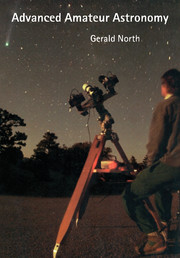Book contents
- Frontmatter
- Contents
- Preface to the second edition
- Preface to the first edition
- Acknowledgements
- 1 Telescope optics
- 2 Atmosphere, seeing, magnification and eyepieces
- 3 Telescope hardware and adjustments
- 4 Astrophotography with the camera
- 5 Astrophotography through the telescope
- 6 Electronic imaging
- 7 The Moon
- 8 The terrestrial planets
- 9 The gas-giant planets
- 10 Asteroids, comets, meteors and aurorae
- 11 The Sun
- 12 Variable stars and novae
- 13 Methods of photometry
- 14 Double stars, star clusters, nebulae, galaxies and supernovae
- 15 Spectroscopy
- 16 Radio astronomy
- 17 Further information
- Appendix: Useful formulae
- Index
- Frontmatter
- Contents
- Preface to the second edition
- Preface to the first edition
- Acknowledgements
- 1 Telescope optics
- 2 Atmosphere, seeing, magnification and eyepieces
- 3 Telescope hardware and adjustments
- 4 Astrophotography with the camera
- 5 Astrophotography through the telescope
- 6 Electronic imaging
- 7 The Moon
- 8 The terrestrial planets
- 9 The gas-giant planets
- 10 Asteroids, comets, meteors and aurorae
- 11 The Sun
- 12 Variable stars and novae
- 13 Methods of photometry
- 14 Double stars, star clusters, nebulae, galaxies and supernovae
- 15 Spectroscopy
- 16 Radio astronomy
- 17 Further information
- Appendix: Useful formulae
- Index
Summary
Spectroscopy is surely the most neglected of all the possible methods of observing by the amateur astronomer. This is not really very surprising. For one thing few amateurs have the necessary grounding in physics to make much headway with this analytical technique. Even if they have, a large telescope is required to obtain high dispersion spectra (explained later) of even quite bright celestial bodies and there is little that one can do to advance modern astronomy by taking low dispersion spectra of bright objects (with, perhaps, just one or two notable exceptions).
Nonetheless, I thought that I would include a few notes on spectroscopy in this book. Not every activity of the amateur astronomer necessarily has to advance science. There is also the enjoyment factor and the kinship created by pursuing a technique much used by his/her professional colleagues. Consequently I have restricted my treatment of this subject to just the areas likely to be of most interest and use to the backyard observer.
Fundamentals of electromagnetic radiation
Visible light is just one form of electromagnetic radiation. Figure 15.1(a) shows the classic ‘radio tuning dial’ representation of the electromagnetic spectrum. In some ways this radiation behaves as a stream of particles, or photons, but in other situations it behaves more like a stream of waves. In reality it is both. Figure 15.1(b) illustrates the concept of wavelength. Some people like to think of a photon as a ‘packet of wave energy’.
- Type
- Chapter
- Information
- Advanced Amateur Astronomy , pp. 334 - 364Publisher: Cambridge University PressPrint publication year: 1997



